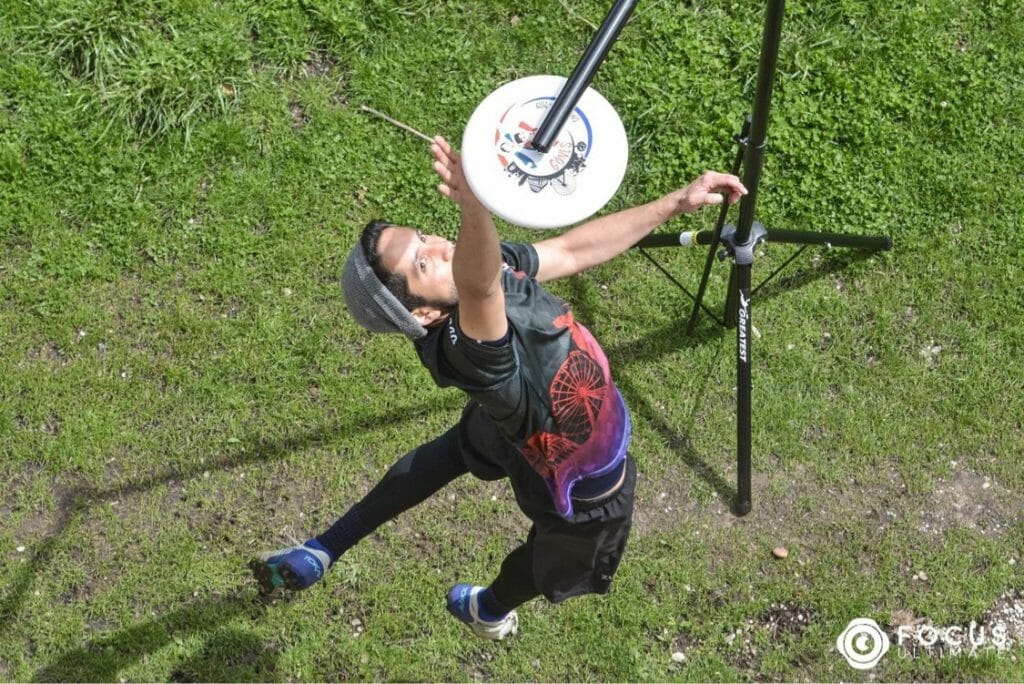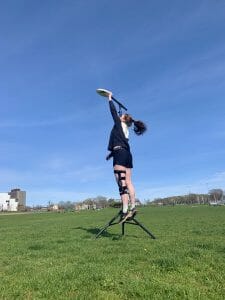Is the Greatest Sky Trainer your ticket to putting opponents on a poster?
May 12, 2021 by Kelsey Hayden in Review, Sponsored with 0 comments

Ultiworld was compensated for this review by Greatest Bag. Opinions are solely those of the reviewer.
When I was asked if I wanted to review one of the new Greatest Sky Trainers, I jumped at the opportunity (pun intended). I love trying out new products and of all the workouts or training that you can do for ultimate, plyometrics is my favorite. So the idea of having a tool specifically designed for ultimate that specifically tests and measures one of my favorite skills was pretty appealing.
Setup & Breakdown: 9/10
 The package comes with a one-page set of instructions. The instructions are simple: there are steps to follow1 and an accompanying picture. The first time I set it up, I timed myself and it took just over five minutes. I’ll admit this included a short period of time where I was confused because I only half-read the instructions before starting assembly. Once I realized I should just follow what was given to me, it was a breeze. I suspect with repeated uses — or better reading comprehension skills — this time could easily be cut in half. There are only a few pieces — the tripod base (which comes already assembled in the tripod), three vertical poles to connect to one another, and the overhead bar where you fasten the disc.
The package comes with a one-page set of instructions. The instructions are simple: there are steps to follow1 and an accompanying picture. The first time I set it up, I timed myself and it took just over five minutes. I’ll admit this included a short period of time where I was confused because I only half-read the instructions before starting assembly. Once I realized I should just follow what was given to me, it was a breeze. I suspect with repeated uses — or better reading comprehension skills — this time could easily be cut in half. There are only a few pieces — the tripod base (which comes already assembled in the tripod), three vertical poles to connect to one another, and the overhead bar where you fasten the disc.
The kit does not come with a disc, so you need to grab your own. You’ll need to attach the included magnet to its underside with some tape so that the disc will stick to the overhead bar and reset pole.
Taking down the Sky Trainer is even easier than setting it up. You simply disconnect each piece from one another, toss all the parts in the included bag, and that’s that.
First Impression: 8/10
 All the parts of the Greatest Sky Trainer fit in a long drawstring bag, which is included in the package. The bag is a handy addition — it’s black and about 3′ long with one long strap making it easy to grab and sling over your back. Everything you need combines to be about 10 lbs, making it portable and easy to tote around. I loved that I could pop this on my back and walk to practice without much trouble.
All the parts of the Greatest Sky Trainer fit in a long drawstring bag, which is included in the package. The bag is a handy addition — it’s black and about 3′ long with one long strap making it easy to grab and sling over your back. Everything you need combines to be about 10 lbs, making it portable and easy to tote around. I loved that I could pop this on my back and walk to practice without much trouble.
The Sky Trainer can range in disc height from 2.4 m (7’10”) to 3.6 m (12’). With this kind of range, it’s pretty much suitable for any able-bodied adult ultimate player to practice with. The heights are clearly listed on the poles in white font on a black background. The whole system looks pretty sleek since it has minimal branding, and I like that.
One thing I would have liked to see was a way to easily measure the height of your standing reach. This isn’t a huge downside — measuring your standing reach height against a wall is simple — but it would have been a nice extra feature to have the measurements right on the pole so you could know the exact height of your standing vert or running vert quickly and easily.
Ease of Use: 8/10
Once I had the Sky Trainer set up, it was time to adjust the height and start jumping. For me, understanding the height at which I was setting up the disc was not intuitive. To be honest, I stood there for at least a good minute or two completely puzzled by what I was looking at. The numbers on the pole are in two sections — they are on the lower pole and the upper pole, with a connector pole (without numbers) in between. The lower pole has the measurements 3.6 m to 3.0 m (in that order, from bottom to top), and the upper section has 3.0 m to 2.4 m (in that order, from bottom to top). My mind just could not grasp why the numbers were descending up the length of the pole and there were no numbers on the connector pole.
My confusion must have been obvious because, after a couple of minutes, a teammate came over, took a few moments to survey the situation and cracked the code. When you want to test lower heights (up to 10′), you don’t use the lower pole at all (it just slides away into the tripod base) and you’re left with just the connector pole and upper pole. The measurement the connector pole reaches on the upper pole indicates the height of the disc. So if you had the Sky Trainer set up to be as low as possible, almost all of the upper pole would be tucked into the connector and you’d see 2.4 m left on the visible part of the pole.
Look, I don’t know if this is a personal problem or if it’s actually a little counter-intuitive. But either way, once I realized how it worked, it was very simple to use. You can adjust what height you’re testing pretty quickly by sliding the poles and twisting the locking mechanisms. The reset pole makes it easy to pop the disc back on the overhead bar, too. The magnet is strong so it doesn’t require much balance to keep the disc on the pole, but it can be tricky to get the reset pole off the disc once it’s in position. I suspect this is the type of thing that would get easier and quicker over time as you develop the right technique.
I brought the Sky Trainer to league and lots of friends gave it a go. Everyone enjoyed testing themselves and watching others. It’s fun to just set it at a height, let everyone take a jump, then raise the height and repeat.
Quality: 10/10
All the parts of the Sky Trainer feel like they are high quality. Everything feels sturdy and when it is set up, it feels really stable. Having only had the Trainer for a few weeks, I can’t comment on how it holds up long term, but it definitely feels like each piece is well designed and manufactured. My guess is it will last for years to come.
Value: 6/10
The Greatest Sky Trainer retails for $149.99 USD. For a Canadian like me, that’s nearly $185. So, is it worth it?
 I’ve mulled over this question a lot. The Sky Trainer tests one skill type — and one that can be tested in other ways (my favorite way previously was sticking a post-it note on a wall as high as I could). But it does so in a way that is uniquely ultimate-specific. Touching a wall is not the same as grabbing a disc. So if you’re an individual who wants to repeatedly test your vert, alone, in the most ultimate-specific way possible, this would be a great purchase.
I’ve mulled over this question a lot. The Sky Trainer tests one skill type — and one that can be tested in other ways (my favorite way previously was sticking a post-it note on a wall as high as I could). But it does so in a way that is uniquely ultimate-specific. Touching a wall is not the same as grabbing a disc. So if you’re an individual who wants to repeatedly test your vert, alone, in the most ultimate-specific way possible, this would be a great purchase.
But if you’re like me, coughing up that kind of money isn’t in the budget for one piece of not-particularly-versatile equipment. In my opinion, the bang for your buck would be if a team purchased the Sky Trainer. It’s the type of equipment that many people can use simultaneously and by dividing the price tag 20+ ways, you’ve now got a great tool for only a few dollars each. If your team is training to improve their vert, having this on the sideline of practice would be an excellent motivator.
The Verdict: 8/10
The Sky Trainer does exactly what it advertises and it does it well. Compared to other vert testers on the market, it is more affordable and it’s actually testing the skill in an ultimate-specific way, which is unique and handy. It feels sturdy and durable and it was easy to set up, take down, and carry around.
I was a little confused on how to read the measurements at first, but once I understood, it was simple. I do wish it had an additional ruler to measure standing vertical reach so users could easily know their actual vert, but this is a minor complaint.
Despite its lower price point than comparable products in the market, I do feel it’s still expensive for an individual to purchase. But for a team or organizer, you could get a lot of value by adding this to the equipment bag.
The author did not have access to the video during the review period. ↩